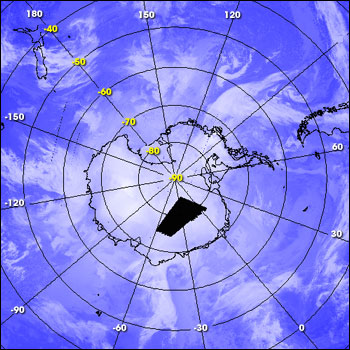

Combating the Weather: MODIS Predicts Flight Hazards |
|||
With McMurdo supplied, the next hurdle Stone had to face was sending airplanes to the other bases and camps to distribute the supplies. This time, the continent’s nearly constant hostile winds, blowing snow, and heavy fog stood in his way. Forecasters in Antarctica provide flight forecasts to keep airplanes as safe as possible, but with few weather-monitoring stations to give them accurate information, their ability to predict severe weather is limited. |
|||
Even as Stone was watching icebergs in the Ross Sea, Matthew Lazzara and Jeff Key, researchers from the University of Wisconsin-Madison, and Andy Archer, a remote-sensing analyst for Raytheon Polar Services, were installing a station at McMurdo to download MODIS data directly from Aqua and Terra as they pass over Antarctica. While the photo-like MODIS Rapid Response images Stone had used to track icebergs were perfect for showing people the current conditions in Antarctica and for making maps, they became available two to three hours after being acquired, when the satellites passed over North America. But in addition to sending down large chunks of stored data at specific stations across the globe, MODIS also continuously broadcasts the data it is collecting via X-band frequency radio. Weather forecasters need data quickly, and data from a direct broadcast receiving station such as the one Lazzara, Key, and Archer installed in Antarctica arrive instantly. These “instant” data help to monitor current weather conditions, augment weather maps, and refine predictions. |

A C-141 airplane makes a delivery to McMurdo Station. Predicting when the weather is safe for flying in Antarctica is especially challenging because ground-based weather stations are scarce. (Photo courtesy Ted Scambos, National Snow and Ice Data Center) |
||

The station was installed at the end of the season, and started operating in April 2005. As such, it couldn’t help Stone plan flights during the 2004-2005 season—it has yet to be tested operationally—but it could improve forecasts during the 2005-2006 season. “It’s brand new to us,” says Art Cayette, the Meteorology Executive Agent for the U.S. Antarctic Program. He’s anxious to return to the ice to try out the new system. “We’re the perfect place to experiment with remote sensing,” he observes. “We have very little real data, so we can really see the effect each new tool has on forecasting models.” |
This infrared Antarctic composite is a mosaic of data from several satellites. This image shows Antarctic cloud conditions on September 6, 2005. (Image courtesy AWS/AMRC Antarctic Composite Satellite Images) |
||